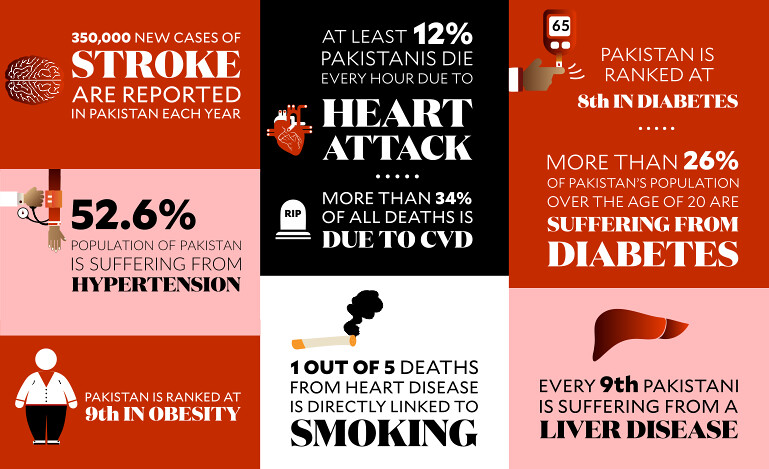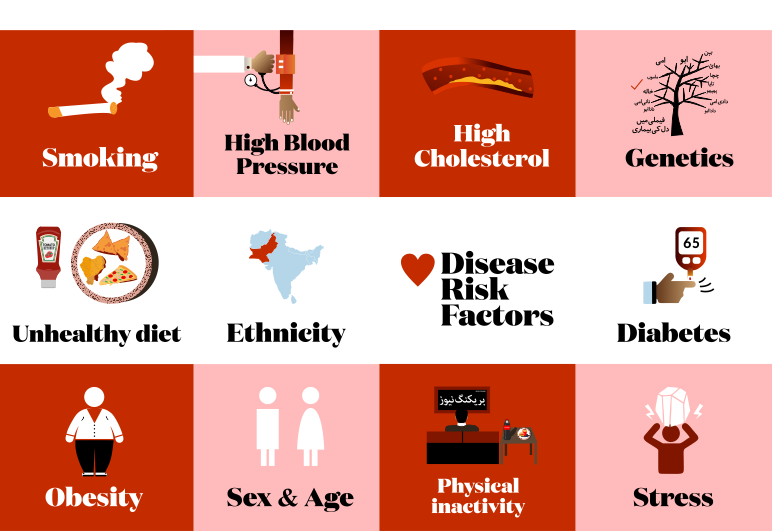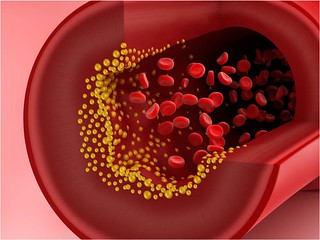South Asians (including Pakistan) are more likely to carry weight around the waist, smoke and not get enough exercise, which can all increase the chance of developing various diseases such as high blood pressure, High cholesterol & triglycerides levels and diabetes. This can increase the risk of heart disease and stroke.
What is Cardiovascular Disease?
Cardiovascular disease (CVD) is also known as heart and circulatory disease. It affects the normal working of your heart and blood vessels. CVD includes angina (Chest pain), heart attack, congenital heart disease, hypertension and stroke.
Fatty materials (called atheroma) start to build up in your arteries. This makes the arteries narrow and reduces the blood flow inside the artery. At some time, your artery may become so narrow that it will be unable to supply sufficient oxygen and nutrient rich blood to your heart. When this happens you may begin to feel pain or discomfort in your chest.
A heart attack happens when blood flow is blocked through one or more of the coronary arteries are blocked. Stroke (brain attack) happens when the blood supply to part of your brain is cut off, killing brain cells. CVD can damage arteries in brain, heart, kidneys and eyes.
Are Pakistanis at risk of developing heart disease?

Heart disease risk factors
The more risk factors you have, the more likely you are to develop heart disease. You can develop heart disease, if you have these risk factor:

Smoking – Smoking doubles your risk of dying from a stroke. Some people smoke cigarettes, but shisha also use tobacco. In one session of using shisha you can inhale as much smoke as if you smoked 100 cigarettes.

High blood pressure – High blood pressure is strongly linked to heart disease. High blood pressure (also referred to as HBP or hypertension) is when your blood pressure, the force of blood flowing through your blood vessels, is consistently too high. Learn more

High Cholesterol – Pakistani’s tend to have lower levels of HDL (good cholesterol).More likely to have fatty deposits in their arteries and higher levels of triglycerides. This combined with other risk factors increases the risk of heart disease and stroke significantly. Learn more ( link to cholesterol Infographic)

Obesity – Pakistani’s tend to carry more weight around their waist, which puts them at risk to develop high blood pressure, diabetes and other health issues.

Diabetes - It happens when the blood can’t control the amount of sugar in the blood. There are 2 main types of diabetes.
- Type 1: When the body stops producing insulin – a hormone for controlling blood sugar
- Type 2: It happens when the body does not produce enough insulin or the body’s cells do not react to insulin in the right way. It is associated with obesity and physical inactivity

Physical inactivity – Physical inactivity or sedentary lifestyle is the leading cause of type 2 diabetes and various other health issues including heart disease.

Ethnicity – South Asians( it includes Pakistan, Indian, Bangladesh and the rest of SAARC nations) are at a higher risk of developing heart disease sue to genetics and sedentary lifestyle and high caloric diets.

Sex & Age – Men are more likely to have CVD at earlier age than women. The older you are, the more likely you are to develop heart disease.

Genetics – You are more at risk of having a stroke or of developing heart disease if someone in your family has coronary heart disease.

Unhealthy diet – High sugar, salt and fatty diet can lead to various health issues including heart disease, stroke and kidney disease among others.

Stress – Stress is not a direct risk for heart and circulatory diseases, but it’s possible that it may contribute to your risk level. It all depends on your coping mechanisms. Some people cope with stress with risky behavior – such as smoking, overeating, drinking too much alcohol. If you already have coronary heart disease and under a lot of stress, it may bring on symptoms like angina (chest pain).
Sources:
- Living well with heart disease, Heart and Stroke, Canada, 2018
- Coronary heart disease, NHS Choices, 2018
- Cardiovascular disease, British heart foundation, 2018
- More pakistanis at risk from heart disease, Dawn News, 2017
- 26pc of country's population has type 2 diabetes:survey
- Stroke information for south asian people, stroke, Uk, 2018
- Stress,British heart foundation, 2018
|